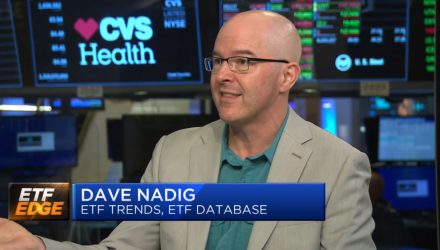On this week’s ETF Edge, CNBC’s Bob Pisani, back in the studio, discusses the growing interest in staying in the market as it continues hitting new highs while still providing downside protection. He is joined by ETF Trends’ CIO and Director of Research, Dave Nadig, along with Simplify ETFs’ Paul Kim, whose firm specializes in alternative strategies and options-based ETFs.
From Nadig’s perspective, the Simplify US Equity PLUS Convexity ETF (SPYC) is just one possible solution for people in need of protection who don’t want to push too hard. As he notes, the investor has to assume they will underperform if the markets are flat or slowly rising, which is the case much of the time. However, strategies such as the one presented in SPYC provide an opportunity to profit or protect when arriving at certain edges.
Nadig continues, “A lot of advisors we talked to spoke of this tipping point market we are in, where it feels, every day, like things are a little overvalued, but they can melt up or meltdown on almost any catalyst. That’s what you’re hedging here.”
This category of protection ETFs has, in general, pulled in a lot of money over the last year. It’s not a huge area, though $5 billion is certainly a lot for one sector to handle based on some solid products/funds available. Initially, a lot of this came down to finding ways to protect against inflation.
Funds That Protect
That means putting support behind funds such as the Horizon Kinetics Inflation Beneficiaries ETF (INFL) and the Krane Shares Trust – Quadratic Interest Rate Volatility and Inflation Hedge ETF (IVOL). These funds protect against tips, curve steepening, and rising interest rates, making it a multi-hedge strategy.
Speaking of hedge fund-like products, Simplify did release two recent funds protecting against interest rates and volatility. As Kim explains, the Simplify Interest Rate Hedge ETF (PFIX) allows access to ETF investors and the “swaptions” market, specifically, as it is the most liquid and the most cost-efficient way of getting interest rate detection.
For the Simplify Volatility Premium ETF (SVOL), as Kim notes, “We’re essentially collecting a preview. If you look around the marketplace – how do you deliver a yield, return, or income in a very low-income environment?” With fixed income struggling and equities having low-dividend yields, the volatility premium is one of the most attractive premiums.
There’s a significant demand for insurance that has everyone thinking about protecting their portfolio, so they are buying things like puts. Additionally, they are buying calls to protect their upside, creating a very steep VIX curve, which essentially drives a lot of carry potential.
Watch The Full Episode of ETF Edge featuring Dave Nadig
For more market trends, visit ETF Trends.
